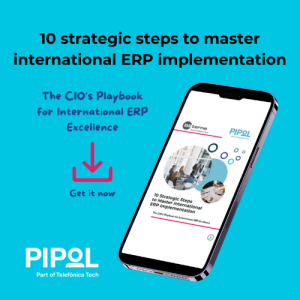Business transformation: 4 steps to bridge business and IT
IT plays an increasing role in long-term business transformation. Most organizations have great expectations when it comes to their IT investments, hoping for reduced costs, standardized processes, enhanced productivity, improved workflow and communications, and the possibility to implement new business strategies and gain competitive advantage. However, a large number of ERP projects fail, causing loss of money and profitability, internal mistrust and leaving a bitter after taste. Too many new systems turn out not to support business procedures, resulting in missed opportunities to drive revenues, grow market shares and increase speed of business Why? Well, mostly because of a disconnection between business and IT, characterized by siloes, little shared understanding or focus and lack of common business goals.
Business transformation: why is it so difficult?
Several factors can be critical to the success (or failure) of your business transformation or ERP project, for example resistance to change from users, a piece of software not properly adapted to business processes, or even a market change. IT projects always face the challenge of taking two very different viewpoints into account – the business point of view on the one side, and the IT/technical perspective on the other. From the business point of view, the main focus is to identify the business challenges and understand how a given solution will address specific needs. From the IT point of view, it is often about understanding the technology best fit. Problems start when a technology-centric IT strategy, focusing merely on technology products, meets a business strategy. The two sides simply don’t speak the same language. If IT is not involved in defining the strategy and business planning, it risks to become an afterthought, rather than a part of forming the corporate skeleton and central nervous system of the organization. And that is when problems and failures occur.
What can you do about it?
It is vital for the success of your project to move away from “IT as an afterthought” and instead apply a business-oriented approach, where business and IT define and work towards common business goals – both addressing the same fundamental question: Where do we need to be in the future and how do we ensure that our IT supports our business goals and evolution, today and in the future?
Business transformation is not easy, but here are a few short tips that you can use to bridge business and IT :
- Understand your organization: The result of your project will be no better than your initial analysis. Understand where you stand today (taking into account the human, business and technology dimensions) before you start planning where you want to go. It will help you gain a clear and realistic view on the organization including challenges and possibilities to achieve your strategic goals.
- Know your stakeholders and engage them: Stakeholder management is critical to the success of every project in every organization. Resistance to change or lack of commitment can be solved by engaging the right people in the right way. Identify the individuals or groups that are likely to affect or be affected and make sure to involve them, communicate with them so that they will in turn become evangelists of your project and strategy.
- Find a common language and common business goals: Make sure that both technical and non-technical audiences share a unified knowledge base with common business goals, a common vocabulary and a common reference model – whether people stand on the business or IT side. This way you will ensure that everybody is on the same page with priorities.
- Ensure Top management involvement: Your ability to gain buy-in and support from across the organization is dependent on the involvement and commitment of your top management.
Bridging business and IT is about moving towards a business-oriented approach, where business and IT work together towards common business goals. By understanding your organization, knowing your stakeholders, finding a common language, setting common business goals and ensuring top management commitment you will be able to establish the fundamental knowledge, shared understanding and cross-functional cooperation that is essential to the success of your project.
So, is your organisation on the verge of implementing an ERP solution and needs help assessing if the project is doable? Realistic? Aligned? Financially sound?? Then check out our new Readiness Assessment right here.





